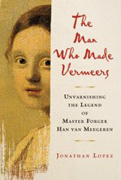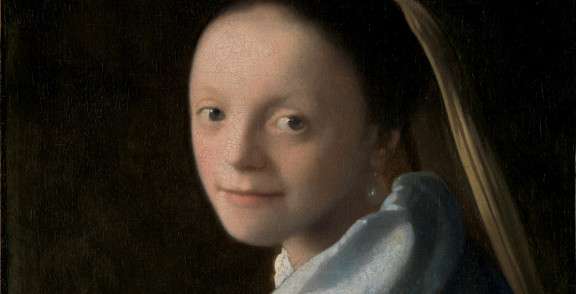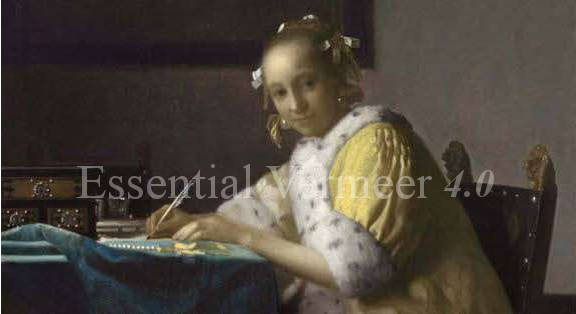from the cover of: The Man who Made Vermeers:
It's a story that made Dutch painter Han van Meegeren famous worldwide when it broke at the end of World War II: a lifetime of disappointment drove him to forge Vermeers, one of which he sold to Hermann Goering, making a mockery of the Nazis. And it's a story that's been believed ever since. Too bad it just isn't true.
Jonathan Lopez has done what no other writer could--tracking down primary sources in four countries and five languages to tell for the first time the real story of the world's most famous forger. Neither unappreciated artist nor antifascist hero, Van Meegeren emerges in The Man Who Made Vermeers as an ingenious, dyed-in-the-wool crook—a talented Mr. Ripley armed with a paintbrush, who worked virtually his entire adult life making and selling fake Old Masters. Drawing upon extensive interviews with descendents of Van Meegeren's partners in crime, Lopez also explores the networks of illicit commerce that operated across Europe between the wars. Not only was Van Meegeren a key player in that high-stakes game during the 1920s, landing fakes with powerful dealers and famous collectors such as Andrew Mellon (including two pseudo-Vermeers that Mellon donated to the National Gallery of Art in Washington, D.C.), but the forger and his associates later offered a case study in wartime opportunism as they cashed in on the Nazi occupation.
The Man Who Made Vermeers is a long-overdue unvarnishing of Van Meegeren's legend and a deliciously detailed story of deceit in the art world.
- Click here for a slide show of all the images from the book.
- Click here for an extract containing the introduction and first chapter
- Click here for the book website
- Click here for New Yorker review
March 15, 2009
The Essential Vermeer: The Han van Meegeren case is by far the most "popular" and written-about art forgery scam of all times. What piqued your interest to take on the topic yet again?

Jonathan Lopez: There have been many books on Van Meegeren over the years. Some of them aren't bad. But none of them really gets at the issues that interested me most. In writing my book, I wanted to go back to the original Dutch sources—trial testimony, investigation reports, correspondence, etc.—and really bear down hard on the facts of the case in a way that hadn't been done before. I wanted to steep myself in the literature of the period and to present the story with a deep sense of history, because that's really the key to understanding Han van Meegeren. He was a product of his times to a degree that I think other treatments of the subject have missed.
Perhaps the most far-reaching accomplishment of your book is that it answers a question avoided by those who have taken up the subject previously: how could the most renowned museum curators, art dealers, and private collectors have been taken in by fakes that appear almost laughable today?
This is exactly where a sense of history becomes important.
Yes, but the way you go about answering this question involves more than history. There's also an idea. You discuss Van Meegeren's forgeries in the context of twentieth century art and politics and propose that "a fake doesn't necessarily succeed or fail according to the fidelity with which it replicates the distant past but on the basis of its power to sway the contemporary mind." Could you elaborate on that a little more?
JL Well, I'm not the first person to notice that forgeries tend to incorporate elements of the visual culture of their own period, and that this is one of the reasons that they can become so seductive—because they seem to suggest that these great painters of the past were so talented and so ingenious and had so much to say about life and the world that they actually anticipated our own concerns. But I try to delve into this idea with greater specificity and depth than has generally been done, particularly with reference to Van Meegeren's later biblical Vermeer forgeries, which strike most people today as simply baffling.
They are very ugly paintings.
That's true. They are. Van Meegeren's Supper at Emmaus looks like an episode of The Munsters. And yet the great expert Abraham Bredius declared it to be the Vermeer's greatest masterpiece in 1937. It was praised in the newspapers when it was first "discovered"; it hung in a major museum; exhibitions were organized around it; poetry was written in its honor. This was no small achievement for a forgery. But Emmaus and the other biblical Vermeer forgeries succeeded for a good reason: they really did blend in with the contemporary visual culture of their time. And today it's very hard for us to see that, because the elements of contemporary culture that they were drawing upon, or from which they sprung, were essentially wiped away, wiped off the face of the earth after the war.
How so?
In essence, what these forgeries had done was to re-interpret Vermeer in the light of art inspired by Nazi ideology—with which Van Meegeren, by the way, sympathized. In the book, I tease this out by pairing the forgeries with actual Nazi propaganda art produced during the time, including Nazi-influenced works that Van Meegeren himself produced during the war (under his own name) for the German occupation government of the Netherlands. The late Vermeer forgeries are basically a Nazi fantasy of Vermeer, and this was, of course, an entirely plausible image of Vermeer if you happened to be living in occupied Europe during the war, when Nazi imagery was an absolutely ubiquitous part of daily life. But today these fakes are stranded on a historical desert island. We don't know what they're referring back to. And they just look weirder and weirder as time goes by.
Was Van Meegeren actually a Nazi?
His relationship to Nazism was complex. On a personal level, Van Meegeren greatly admired Hitler—a fellow traditionalist artist, among other things—and he was a big fan of Mein Kampf, which he read just shortly after it came out. Then, during the war, he did these commissioned artworks for the Nazis. He also gave large sums to Nazi causes, joined Nazi-sponsored arts organizations, and once even sent an inscribed book of drawings to Hitler as a token of appreciation. So, I think it's fair to say that Van Meegeren found Nazism quite appealing. On the other hand, though, he never officially joined the Party and, despite occasional crude comments, he wasn't a pathological anti-Semite. Van Meegeren's interest in the Nazi movement, like virtually everything else about Van Meegeren, was mostly narcissistic. He liked the idea of being the Übermensch, of standing, as it were, outside of history and bending the world to his will. For a forger, that's a very powerful idea.
After years of research, you probably know Van Meegeren better than anyone else. Could you sketch us a portrait of Van Meegeren, his personality, character, psychology, etc.?
If you look at photos of Van Meegeren from his trial in 1947, you'll see that he looks a bit like the old movie actor David Niven—silver hair brushed back from his forehead, impeccably tailored suit—all very soigné. He predated Ian Fleming's novels, but he cultivated the kind of amused disdain that we might associate with a James Bond villain. In fact, I think he would have liked people to imagine him that way—as a sort of dangerous, impressive character with whom you would fear to bandy words. But the thing is that no one ever really took him all that seriously because he was so over the top, especially in his cynicism, which tended to become quite voluble when he was drunk, which he often was. Also, he was extremely short. And he spent a lot of time chasing after very tall women, which inevitably made him seem like a bit of a sight gag—an amorous, overdressed pipsqueak. He was definitely more like Dr. Evil than Dr. No.
Did you enter your research with a thesis in mind, or did the accumulation of evidence suggest your book's viewpoint on Van Meegeren?
I had read and admired Marijke van den Brandhof's book on Van Meegeren, Een vroege Vermeer uit 1937 (Utrecht: Spectrum, 1979), which was the first to document Van Meegeren's Nazi connections, and I felt that it might be possible to go a bit further with this, to see where, biographically, these right-wing leanings might have come from in Van Meegeren's life and to what extent they were related to his career as a forger. So, I think I had the basic framework going into the project, but I allowed the evidence to be my guide along the way.
Can you describe the methods you used to research the subject?
I did a lot of work in the state and municipal archives of the Netherlands. People kept telling me that I would never find anything—that the story was so old that there was no new material to discover—but there were lots of documents, particularly relating to the war years, that had never been exploited before. You just had to know where to look. For instance, if you knew the names of all of Van Meegeren's friends and associates, you could turn up information about him in dossiers pertaining to them. I discovered a lot of new material that way. I also contacted descendents of people who knew Van Meegeren, especially descendents of his partners in crime. Their oral histories gave me leads for my archival research. Sometimes their stories proved to be verifiable; other times not.
Did your background as an artist help you?
I tried to examine every Van Meegeren forgery whose location is known, and being a painter definitely helped me understand what I was looking at. Van Meegeren had to invent completely new working methods in order to surmount some of the technical hurdles involved with forging Old Masters. For instance, none of his forgeries is actually painted with oil paint. In fact, it's virtually impossible to forge an Old Master using oils, because oil paint can take up to a hundred years to dry and harden completely. So, a fake made with oils would be "soft" and fairly easy to unmask as a forgery. To get around this problem, forgers have, over the years, come up with any number of fast drying media to use in place of oils. In his earliest forgeries, for example, Van Meegeren used a paint based on gelatin glue, which hardened very quickly. But gelatin was actually not that difficult to detect if you knew what to look for, so it was risky to use. In his later forgeries, like Emmaus, Van Meegeren switched to a modern synthetic material that was virtually impossible to analyze using the scientific methods available at the time—Bakelite.
Bakelite is a kind of plastic?
It's actually much more similar, in both its chemical and working properties, to the two-part epoxy resins commonly found in hardware stores today. You've seen this stuff, haven't you? It comes in a syringe with two vials. You mix the contents of the two together to activate it. In any case, if you've ever used epoxy around the house, you know that it's really runny, sticky stuff. So, imagine trying to paint a large, multi-figure, narrative history painting with a material like that. It would be pretty difficult. In order to work with Bakelite, Van Meegeren basically had to unlearn everything he knew from working in oils and re-invent his whole method of painting. He would apply very small amounts of the pigmented Bakelite to his canvas and then quickly pounce it smooth before it became too tacky to work with. If you examine the forgeries under magnification, you can see how it was done. It must have been an incredibly tedious way to work. But this is what forgery is all about. It's not just about imitating Vermeer. There are many other considerations that go into creating a credible fake.
How did museum personnel whose collections have a Van Meegeren on their hands receive you?
You know, there's this great myth that museums who own these old fakes are embarrassed by them and that this why they keep them in storage. Nothing could be further from the truth. Curators are generally quite amused by the fakes in their collections, and I've never yet had anyone turn down a request to see one. Fakes are kept in storage mostly because no one really knows what else to do with them. How do you display a fake? What do you say about it? Also, due to the way they're made, fakes often deteriorate badly in a physical sense, and it's difficult to keep them in presentable condition for display. quite literally, they aren't made to stand the test of time.
Why did Van Meegeren fixate on Vermeer?
Back in Van Meegeren's day, scholars were still attempting to sort out who Vermeer really was as an artist. Very few authentic paintings by him were known to exist, and most of them had been identified only in recent decades. So the Vermeer forgeries that came on the market played up to this atmosphere of inquiry and investigation. They proposed a fictional narrative of Vermeer's career, answering the implied question, "What else did Vermeer do?"—for instance, did he do portraits, did he do religious scenes, and so on. But from today's vantage point, these forgeries now seem astonishingly anachronistic, because they weren't really about Vermeer per se: they were about the way that the twentieth century looked at the seventeenth century. Van Meegeren's earliest attempts at Vermeer forgeries, for instance, have much more in common with his own 1920s society portraits than with any real work by Vermeer. But at the time, of course, this went unnoticed and, in fact, probably made the fakes all the more appealing on a subconscious level. They seemed both authentically old and hauntingly up to date.
Did your investigation change your perception of the art of Vermeer?
JL The fakes only underscore what a precious legacy Vermeer's body of work really is. No more than 36 pictures by his hand are known to exist. It's remarkable. And Vermeer is timeless—unlike the fakes, whose time has come and gone.What is your opinion of Van Meegeren's legitimate work? Would there be any sense in any kind of Van Meegeren exhibition?
It's often said Van Meegeren had no talent. Personally, I think that's a bit too harsh. He actually did have some real ability, and he enjoyed a measure of success as a society portraitist during the 1920s. But as he became involved with forgery, he lost his way as an artist. In his review of my book in The New Yorker, Peter Schjeldahl had a wonderful line about this: "The state of being oneself dies when set aside." There actually was a Van Meegeren exhibition in Rotterdam back in 1996, to coincide with the big Vermeer show at the Mauritshuis in The Hague. It was interesting, but a bit too large, I thought. Really, a little Van Meegeren goes a long way.
If you could meet face to face with Van Meegeren today and ask one question, what would it be? What don't we know that we need to?
Well, if it really were Van Meegeren, I wouldn't trust a word he said. But it would be nice to know more about his early career. There have been rumors about him as a forger that date back to newspaper articles from the 1920s. But when he was arrested at the end of the war, Van Meegeren only confessed to the fakes that the authorities already knew about, all of which were made after 1936. People have long suspected that there must have been more. Paul Coremans, who worked on the Van Meegeren court case, for example, maintained a lively correspondence on the subject. In the course of my own research, I was able to trace three Vermeer forgeries of the 1920s back to Van Meegeren through documentary evidence, visual analysis, and interviews with the family of one of Van Meegeren's associates. I wrote up those findings in an article for Apollo called "Van Meegeren's Early Vermeers." I also incorporate this material into the book. The case is fairly compelling, but there can always be room for doubt as Van Meegeren never claimed these particular fakes as his own. Of course, I suppose there could be equal room for doubt about the attribution of many pictures, when you come right down to it. Wouldn't the Rembrandt Research Project have a much easier time if they could just ask the old fellow, "Excuse me, Mr. Van Rijn, is this one over here yours?"
Would you afford Van Meegeren one saving grace?
Personally, I find Van Meegeren utterly fascinating, and I always will. For all his faults, he was intelligent, clever and profoundly resourceful—a truly brilliant fraud. And in an era when we have Bernard Madoff running around, and our entire economy looks more and more like a Potemkin village every day, I think Van Meegeren can probably still teach us a thing or two.
Could a Vermeer forgery happen again today? Have we completely assimilated the case?
I would have to say that the chances of anyone passing off a Vermeer forgery today would be pretty much non-existent. A good con artist always tries to find the common ground between what people want to hear and what he wants them to believe. In Van Meegeren's day, experts fully expected that more Vermeers would turn up, so Van Meegeren was able to work within the bounds of that conceit. Today, however, no such expectation exists, so creating a fake Vermeer would be a non-starter. That's not to say that forgery has ground to a halt. Good, convincing fakes continue to get made, and they continue to deceive laymen and experts alike. For instance, until Scotland Yard recently encouraged him to retire, John Myatt enjoyed a nice run duping the experts at Christie's and Sotheby's with fakes in the style of Matisse, Chagall, Gleizes and Dubuffet. Forgery will always be with us. But it takes different forms in different eras.
The success of The Man Who Made Vermeers has been amply confirmed by enthusiastic reviews, robust sales, award nominations, and numerous public lectures you have given. What is your next topic?
I'm looking at a few possible subjects. The sort of work that I like to do tends to be research-intensive, so it may take a little time to refine a topic. But I'd definitely like it to be Dutch, and I'd prefer it to involve a completely admirable figure this time around. Van Meegeren is a very dark personality, and after four years in his company, I think it's probably time for me to move on.

The Man Who Made Vermeers: Unvarnishing the Legend of Master Forger Han van Meegeren
by Jonathan Lopez
2008



